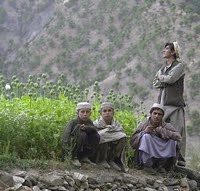On the morning of June 9, 2008, U.S. drug enforcement agents alongside NATO military personnel and Afghan commandos raided a suspected drug weigh-station in southern Afghanistan's Kandahar province near the border with Pakistan. Code-named Operation Albatross, the counternarcotics mission was the result of a tip from a government official in Kandahar and led to a seizure of mind-blowing proportions: 262 metric tons of dried hashish, equivalent in size to 30 London-style double-decker buses. The raid was the world's largest drug seizure ever conducted by law enforcement authorities. But there is little reason to celebrate.
Afghanistan's narcotics industry has become a familiar news story recently, but most of the media's attention has focused on poppy crops. Agricultural production of the plant needed to fabricate opium and heroin has indeed skyrocketed since the U.S invasion, with the country supplying over 90 percent of the world's illicit opium and heroin for six years in a row. It was no surprise, then, that many observers welcomed the U.N.'s latest report on Afghan opium, published in early September, which documented a 22 percent decrease in cultivatable hectares of poppy last year.
Less notice was given to the report's observation that Afghan farmers have begun to plant hardier variants of poppy and allegedly used smuggled fertilizer from Pakistan to help increase the typical amount of opium extracted from a hectare of poppy crop. Compared to places like Myanmar and Laos, where poppy farmers typically collect around 10 kilograms of opium per hectare (2.2 acres), poppy farmers in southern Afghanistan last year collected an astounding 56 kilograms of opium per hectare. So despite the decrease in fields devoted to poppy, Afghan farmers still produced 6,900 metric tons of opium, representing just a 10 percent decrease in actual yield compared to last year's harvest.

